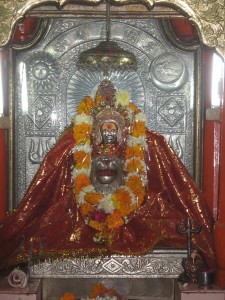History of the temple
Also visit Audichya Brahmins History
 All the information given in this section is provided to me by Shri Kishanpuri Gopalpuri Goswami, Pujari, and Shri Radheyshyam Purshottam Vyas. I am forever in their debt for their invaluable inputs.
All the information given in this section is provided to me by Shri Kishanpuri Gopalpuri Goswami, Pujari, and Shri Radheyshyam Purshottam Vyas. I am forever in their debt for their invaluable inputs.
The origin of this temple is lost in antiquity. The temple was more or less in ruins till Vikram Samvat 2032 (corresponding to Georgian calendar year 1975-1976) when it was renovated by Shri Laljidas Laxmidas Parivar of Chanasma.
The Patotsav of the temple is celebrated by the Dave parivar (community) on Ashadh Sud Aantham which falls roughly in the month of June or July each year.
The story behind the temple is narrated by Shri Radheyshyam Purshottam Vyas as under–
By the grace of Shri Varahi Mataji, the temple site is pre historic. Many centuries ago, the site of the temple was a wilderness. There was a small lake (or pond) nearby the present site of the temple. The ruler of the land ( the narrator uses the word king but probably means the chieftain or lord) was on his way to accompany his (receive his) wife (the narrator uses the word queen) from her parents house to his house.
 It was a long and arduous journey. The king decided to rest awhile under the shade of a Peepal tree (Bo tree, Ficus Religiosa). While resting, the king noticed an object, half buried in the loose soil, which resembled a Shivlinga. He extracted and cleaned the object and found that it was indeed a Shivlinga. Inspired by the divine find, the king installed and worshipped the Shivling with a lotus and water from the nearby pond. Done with his worship, the king decided that he would again pray to the Shivling at this very spot together with his queen in the same manner on his way back. Such a decision is known as sankalpa – a promise to oneself to do a religious deed or an act of donation or achieve a goal.
It was a long and arduous journey. The king decided to rest awhile under the shade of a Peepal tree (Bo tree, Ficus Religiosa). While resting, the king noticed an object, half buried in the loose soil, which resembled a Shivlinga. He extracted and cleaned the object and found that it was indeed a Shivlinga. Inspired by the divine find, the king installed and worshipped the Shivling with a lotus and water from the nearby pond. Done with his worship, the king decided that he would again pray to the Shivling at this very spot together with his queen in the same manner on his way back. Such a decision is known as sankalpa – a promise to oneself to do a religious deed or an act of donation or achieve a goal.
However, it was a few days before he could return with his queen by the same route. On his return journey with his queen, to his astonishment, the king found that there was neither a lake nor any lotuses. He now realized that his sankalpa could never be fulfilled. Not willing to go back on his promise, the king without a moment’s hesitation unsheathed his sword and cut his own head off as an offering to the Shivling!
The queen, shocked at first, now realized that her beloved king had made the ultimate sacrifice to keep his promise of worship. As a dedicated wife, she decided to follow her husband’s example and since the king wanted to worship the Shivling with his queen, the sankalp was only partly achieved. She therefore proceeded to pierce her heart with the sharp katar (a push dagger) concealed on her person. Before she could do this, she hears a voice in her ear saying “Stop, o queen, the lord Shiva does not accept sacrifices of human lives. Your sacrifice will not please him.” The queen looked around but could not see anyone. “Lay a cloth over your king’s corpse and pray to lord Shiva”, the voice continued. The queen, now sure that it was divine intervention, did as she was told.
To her surprise, when she opened her eyes, her husband, the king, was standing before her perfectly alive and well. They both felt the divine presence of lord Shiva near them and bowed before the divine presence which disappeared in an instant. Lord Shiva brought back the dead king to life hence was called Mrityunjaya Mahadev (one who achieves victory over death). The shakti which stopped the queen from sacrificing her life and summoned lord Shiva to the rescue of the king was called Varahi (one who comes to the aid of the distressed).
To this day, Mrityunjaya Mahadev and Maa Varahi are worshipped in this temple. Maa Varahi is known as the kuldevi of Kaudinya gotra and also the patron goddess of the village of Chanasma.
Jai Ma Varahi.